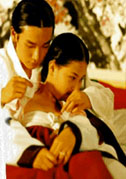
Movie Guru Rating:

Comment
on this review
| |

Chunhyang proves that it's not the story but how it's told
by Adrienne Martini
If Americans have learned anything over the last 20 years, it's that the cultural traditions of others are equally as valid and important as ours. For good or ill, as long as these traditions aren't brutal acts performed against a subjugated group, like, say, what the Taliban is doing to women (among others) in the name of religion, we're willing to absorb and respect that everyone has his or her own way of doing something, especially when it comes to artistic pursuits.
Pick your way to tell a simple story. We have sages who squat by the fire and unravel narrative yarns. The Koreans have a story-telling form called pansori, which is part opera and part interpretive dance, performed solo, usually by a man, who is accompanied by a drummer who both pounds the drum head and taps a stick against its case. A single story can take six to eight hours to unfold, which is not unlike early English theatre, classic Germanic opera, or ancient Indian tales. There's just something about being human, no matter what the national allegiance, that makes us want to tell stories, even though the manner may differ.
The opening of Chunhyang, a new film by Korean director Im Kwon Taek, takes the audience to a pansori performance where Cho Sang Hyun is running through the prologue to the folktale Chunhyang. Cho is clad all in white, caught in a bright spotlight, accompanied only by his drummer and is, despite the lack of visual frills, somehow magnetic.
From this stark beginning, director Im bleeds the story out of the confines of a modern day theater and into the 18th Century Korean countryside, where a young, privileged boy, Mongryong (Cho Seung Woo) falls for a lower class girl, Chunhyang (Lee Hyo Jung). These lush flashback scenes comprise the bulk of the movie, which is intercut by pansori footage. Cho's performance also provides a narrative commentary, kind of like a Korean Greek chorus that gives the listener insight into what the characters are thinking. On paper, this story-within-a-story structure might seem trite. In Im's able hands, it is more wonderfully watchable than you'd think.
Most of the good in Chunhyang comes from the simple yet elegant way in which Im frames his shots, with each piece of each visual composition adding something to the story itself. There is no noise here—on a simply compositional level—and that makes the movie feel like a finely crafted piece of art that also happens to move. The lack of clutter belies how big Chunhyang is; this film is the largest ever in Korean history, employing over 8,000 extras and 12,000 costumes.
Still, the focus is on the two main characters, the young lovers who are separated by class and fate. Mongryong and Chunhyang marry after a remarkably abbreviated courtship, a marriage that happens simply because Mongryong wants to sleep with her. They're forced apart by Mongryong's father, the current governor of the town, who moves his boy out of the provinces and to Seoul, where he will focus on his studies to become a high government muckity-muck. A new governor moves in and tries to claim Chunhyang for his own. She refuses. He sentences her to death. She waits for rescue from her beloved. But will he return for her after he has seen the metaphorical bright lights of the big city?
Even without the accompanying subtitles, the actors' expressive faces would telegraph the bare bones of the story. Cho imbues Mongryong with earnest boyishness and turns this lovestuck, hormonal dip of a character into an interesting and genuine (if still a bit naive) man. But it is Lee who steals the last two-thirds of the film, with her strident pleas, raw vulnerability and frail humanity that would almost make even a staunch feminist agree with her stand-by-your-man raison d'�tre. While Chunhyang at times becomes nothing more than a martyr too dogmatic to even look at her cause—a twist that would have made this interesting movie downright brilliant, like, say, Crouching Tiger, Hidden Dragon—Lee as an actor always skillfully manages to save the character from her own blindness.
Ultimately, though, Chunhyang isn't the powerful force that other recent Asian films (like Crouching, like In the Mood for Love) have been. Some of the responsibility lies on the director's shoulders. Rather than reflect on earlier times from a modern perspective—a task that could have been accomplished during the pansori sequences—Im chooses to tell a simple and well-worn story with reverence rather than critical thought.
But the largest problem, actually, lies in the gap between our cultural modes of story-telling. Despite our embrace of all traditions foreign, pansori is still a hard artform to truly enjoy without a whole lot of exposure. It's not that the idea of it is difficult to grasp; it's more that it is actively difficult to listen to. The sounds the story-teller uses are a strange cross between Zorba the Greek, the Three Tenors, and a smattering of the Three Stooges. Like bagpipes, pansori can be remarkably off-putting and tragic-sounding no matter how happy the tale being told. Without it, though, the movie would lack a layer of carefully wrought texture. But with it, Chunhyang's pansori narrative can become a test of endurance despite the clarity and art of the film itself.

April 19, 2001 * Vol. 11, No. 16
© 2000 Metro Pulse
|